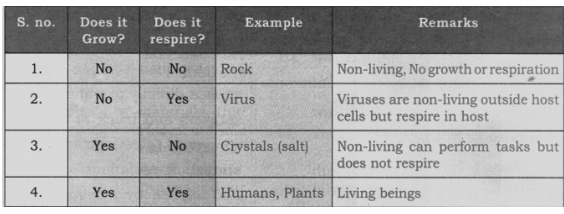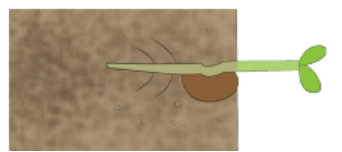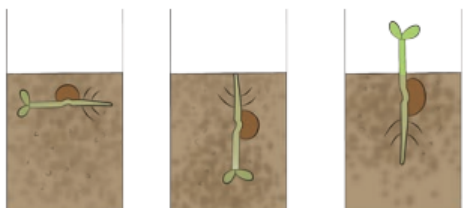How Can Living Creatures Exploring Their Characteristics Class 6 Question Answer Help You Prepare For Exams
FAQs on NCERT Solutions for Class 6 Science Chapter 10 Living Creatures Exploring Their Characteristics
1. What are the main characteristics that distinguish living creatures from non-living things as per NCERT Solutions for Class 6 Science Chapter 10?
According to Class 6 Science NCERT Solutions Chapter 10, living creatures differ from non-living things because they:
- Grow and develop over time
- Respire and obtain energy
- Respond to stimuli in their environment
- Reproduce to make more of their kind
- Show movement, either visible or at the cellular level
- Require food, water, and suitable conditions to survive
2. How does the life cycle of a mosquito differ from that of a frog in NCERT Solutions for Class 6 Science Chapter 10?
While both mosquito and frog life cycles begin with eggs and have aquatic larval stages, their key differences as described in NCERT Solutions Class 6 Chapter 10 are:
- Mosquito: Egg → Larva → Pupa → Adult (respire via siphons during larva and pupa)
- Frog: Egg → Tadpole → Froglet → Adult (tadpoles respire with gills; adult frogs have lungs and skin for respiration)
3. What methods are recommended in NCERT Class 6 Science Chapter 10 Solutions for proper storage of grains and pulses?
To prevent germination and spoilage of grains and pulses, NCERT Solutions recommend:
- Keeping storage containers dry
- Storing in cool environments
- Using airtight containers to limit moisture
4. According to the NCERT Solutions for Class 6 Science Chapter 10, how does adaptation help living creatures survive in different habitats?
Adaptation allows living creatures to survive as they develop features suited to their environment. For example, animals in cold climates may have thick fur, while desert plants like cacti store water. These changes increase their chances of survival and reproduction in specific habitats, as noted in the chapter.
5. How can students correctly identify whether an object is living or non-living as discussed in Science Class 6 Chapter 10 NCERT Solutions?
To identify if an object is living, check if it:
- Can grow and develop
- Shows movement
- Requires food and air
- Reproduces offspring
- Responds to changes in its surroundings
6. What experiment does NCERT Solutions for Class 6 Science Chapter 10 suggest to show the effect of temperature on seed germination?
The suggested experiment for temperature and seed germination involves:
- Planting identical seeds in separate pots
- Keeping each pot at a different temperature (e.g., refrigerator, room, sunlight)
- Providing equal water and soil
- Recording the number and speed of seeds germinated in each condition
7. Why does a tadpole need a tail during its life cycle, as stated in Class 6 Science Chapter 10 Solutions?
As explained in NCERT Class 6 Science Chapter 10, a tadpole's tail provides:
- Swimming ability to move efficiently in water
- Balance and stability for feeding and escaping predators
8. How do plants demonstrate both phototropism and gravitropism during their growth according to NCERT Solutions for Class 6 Science Chapter 10?
Chapter 10 NCERT Solutions state that:
- Phototropism – Shoots grow upwards toward the light to maximize photosynthesis
- Gravitropism – Roots grow downwards into the soil for anchorage and nutrient absorption
9. What are autotrophs and heterotrophs as described in NCERT Solutions for Class 6 Science Chapter 10?
In Class 6 Science Chapter 10 NCERT Solutions:
- Autotrophs are organisms like plants that make their own food by photosynthesis
- Heterotrophs are organisms, such as animals, that depend on others for food
10. How do living creatures reproduce as per the explanations in NCERT Solutions for Science Class 6 Chapter 10?
Living creatures reproduce by either:
- Sexual reproduction, involving two parents, leading to genetically diverse offspring
- Asexual reproduction, requiring only one parent and resulting in offspring identical to the parent
11. What is respiration and why is it vital for living organisms according to Science Class 6 Chapter 10 NCERT Solutions?
Respiration is the process where living organisms take in oxygen and release carbon dioxide to produce energy for various life activities. It is vital as all life processes require energy, as highlighted in NCERT Solutions Chapter 10.
12. How can understanding the life cycle of living things help avoid common misconceptions, based on Class 6 Science Chapter 10 NCERT Solutions?
By studying life cycles in detail (seed to plant, egg to adult), students learn that:
- Not all stages are visibly similar to the parent (e.g., tadpoles vs. frogs)
- Growth, respiration, and reproduction vary at different stages
13. What is the significance of ecosystems as explained in Science Class 6 Chapter 10 NCERT Solutions?
An ecosystem is important because it shows how living creatures interact with each other and with their physical environment, maintaining a balance in nature. Understanding ecosystems helps explain the interconnectedness of life, as emphasized in the NCERT Solutions for Chapter 10.
14. Why is movement considered a key characteristic of living organisms in NCERT Solutions for Class 6 Science Chapter 10?
Movement, even at a microscopic or cellular level, is a universal trait of living organisms. NCERT Solutions Chapter 10 clarify that movement can include actions such as the bending of plants or cellular motion, and not just walking or flying, helping to distinguish living from non-living things.
15. How do NCERT Solutions for Class 6 Science Chapter 10 help students prepare for CBSE, 2025–26 exams?
The NCERT Solutions for Class 6 Science Chapter 10 provide:
- Clear, step-by-step answers for all textbook questions
- Concept-based learning to avoid rote memorization
- Practice with exam-style questions
- Accurate guidance as per the latest CBSE 2025–26 syllabus





























